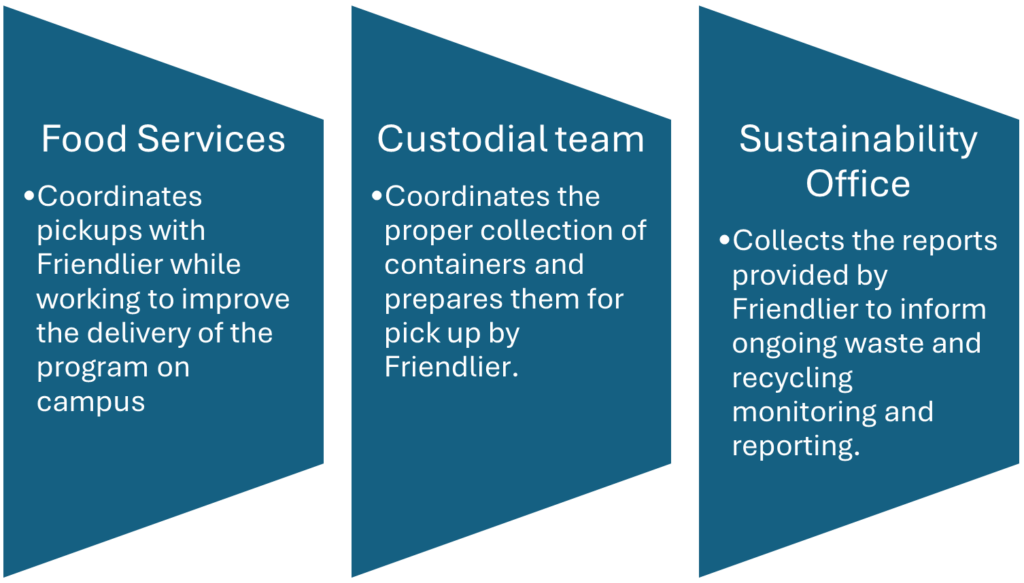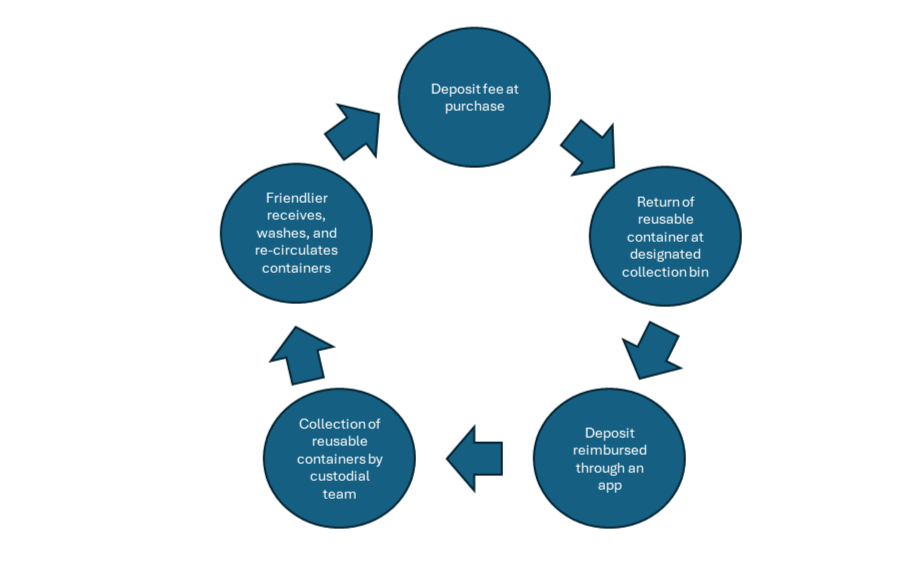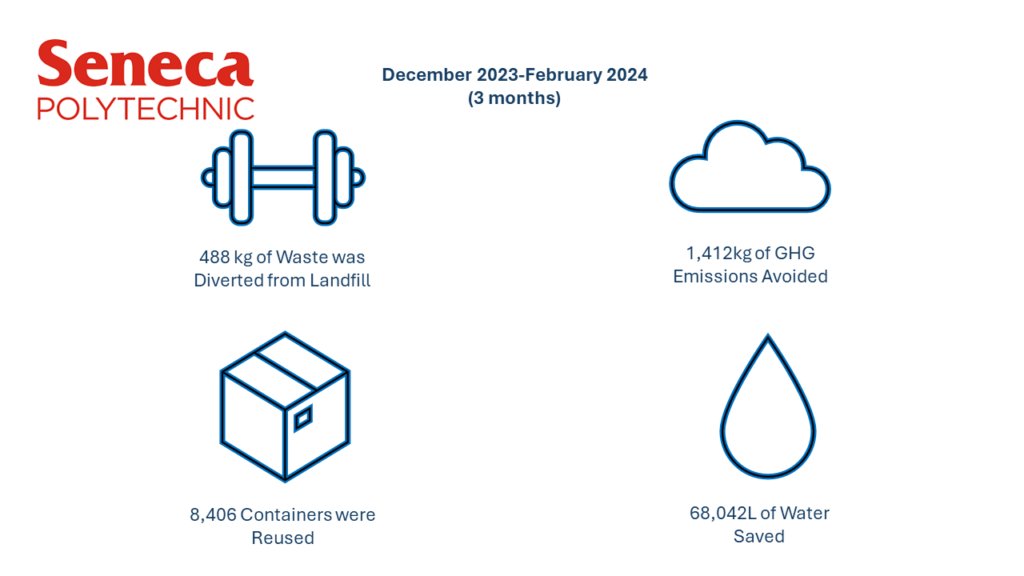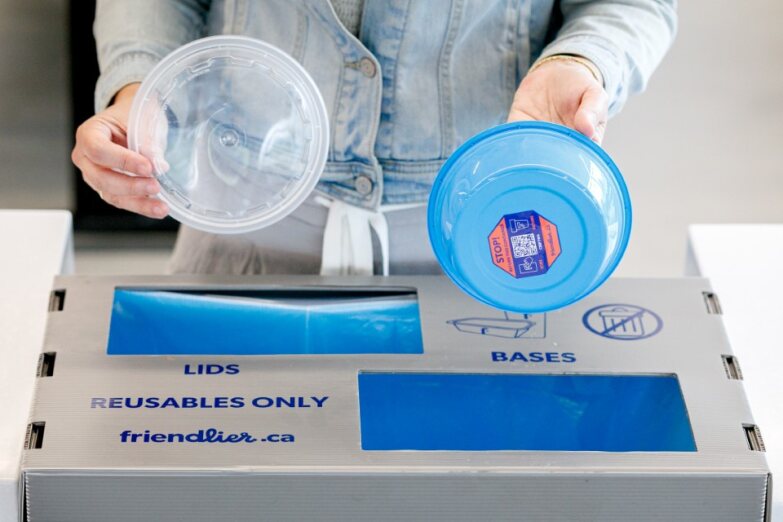To reduce single use plastic waste on campuses, Wilfrid Laurier University (Laurier) and Seneca Polytechnic (Seneca) have independently implemented reusable food ware takeout container programs on their campuses using a reusable food ware service provider, Friendlier. Each institution is at different stages of implementation and seeing different results at the time of this case study.
This case study outlines how these institutions implemented the program and highlights the lessons learned to support other organizations interested in implementing a similar program.
Background
The Single-Use Plastics Prohibition Regulations are the federal government’s plan to address pollution, meet zero plastic waste targets, and support the reduction of greenhouse gas emissions across Canada. Included in these regulations are cutlery and foodservice ware. Therefore, to comply with these regulations, Laurier and Seneca have included supportive language into their Sustainability Plans to reduce the volume of waste generated on campus and to eliminate single use plastics, particularly in food services. Laurier and Seneca decided that using reusable food ware in the cafeteria was the best solution to eliminate single use plastic food ware.
Solution Finding
Laurier had previously piloted a different reusable food container program but did not find success. They had issues with keeping the containers in circulation as they were prone to melting. Both institutions were approached by Friendlier and they decided to pilot the program.
Laurier and Seneca identified the following benefits of using Friendlier’s service:
- Containers do not melt.
- Containers are picked up, cleaned, and brought back.
- Containers do not need to be cleaned prior to being returned (no worries about contaminating the waste stream).
- They are a Canadian brand.
- Monthly reports are provided indicating return rates, the amount of waste diverted from landfill, GHG emissions avoided, and water saved.
- Signage, marketing, and training support is provided by Friendlier (e.g., signage, direct engagement, strategic communication).
Scope of the Project
Laurier started its pilot in the summer of 2022 (2 years ago) and Seneca began in the fall of 2023 (less than a year ago).
The institutions manage their reusable food ware program between the Sustainability Office, Food Services, and the Custodial team. Laurier also involves their Students’ Union for further engagement with students.
Institutional Division of Responsibilities

How Does it Work?
The program is delivered in the same way at Laurier and Seneca except for charging a deposit fee. The different steps are outlined below:
- Deposit: Laurier includes a $0.50-1.00 deposit on the price of a meal purchased by one of the piloting food vendors on campus. Seneca opted to not charge a deposit fee. However, they are reconsidering implementing a deposit to increase return rates.
- Return of reusable container: Once the meal is finished, students can use an app to scan the container and return it to a designated Friendlier collection bin. Then, they will receive their deposit back through the app.
- Collection of reusable containers: Custodial staff collect the empty containers and bring them to a central pick-up location.
- Friendlier: Friendlier staff collect the used containers from the central collection point, wash and re-circulate the containers.

Key Metrics
In the first six months of Laurier’s pilot, the return rate had reached approximately 60% after which two more food service locations were added to the program in January 2023. It was then that the return rate began to decline. Over the following year the return rate fluctuated between 20-30%, sitting at around 27% in February 2024. The Laurier team found the containers were being taken outside the area where collection bins were located, resulting in them being thrown out in the garbage or recycled. After receiving feedback that many students were letting containers build up in their residence rooms, the Sustainability Office had started running monthly collection days for students living in residence which resulted in the return rate slowly climbing back up.


Lessons Learned
Placement of Return Bins
A key learning from Laurier is that placement of return bins is imperative to achieving a high return rate. Since Laurier uses an external vendor to collect waste across campus, the institution is limited in how many return bins can be placed in buildings. With the existing locations being near where the containers are sold, those who are taking their takeaway meals elsewhere, either to class, to the office, or back home now need to either walk the container back to one of the buildings with a return bin or throw the container away. For those trying to replicate this effort, it is recommended that return bins should be placed strategically in areas that make it convenient for users. With the success of the residence collection days, as shown by the increased return rate, it is evident that users want to properly use the program, but if the bins are not located conveniently, the containers will likely end up in either recycling or landfill.
A lot of Seneca’s success is because they have a stand-alone campus without other options for food containers, other than franchises, and people tend to stay in one place to eat or it is easy to determine where people eat and dispose of their lunch to know where to put collection stations. This program would be most effective in these situations.
Education
It is important to put effort into communication and education of the program, both directly at the collection stations and. indirectly through communication channels to reach all stakeholders in the methods that work for them. Also, it is recommended that waste management programs be integrated into onboarding and orientation, and repeating campaigns every semester to capture new students.
Communicate Impact
It would be helpful to communicate the impacts of using the reusable containers through different marketing and communication channels, including on social media. Through a special project with a Laurier community psychology class on campus,[CC1] students conducted interviews with students from other classes and found that when users knew that containers saved 58g of plastic or 168g of GHG emissions from being released when returned, they were more likely to follow the proper steps of the program.
Clear & Effective Messaging
Visual aids should highlight key information on how to use the program in areas where return bins are placed. Having the signage stand out from other waste streams is important. Through direct engagement on the Laurier campus, it was discovered that many users were returning the containers to the appropriate bin, but not scanning the containers to get their money back which in turn affects the return rates.
The Circular Economy Leaders Consortium (CEC) brings together multi-sectoral sustainability professionals focused on reducing facility waste. Members of the CEC attend facility tours, virtual knowledge sessions, and roundtable discussions to share lessons learned and fast track waste reduction at their respective organizations. If you are interested in learning more about the CEC, please contact Chaya.Chengappa@trca.ca

